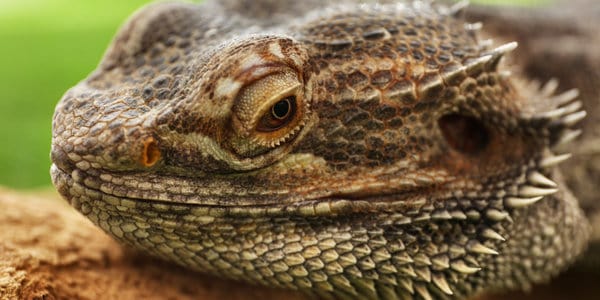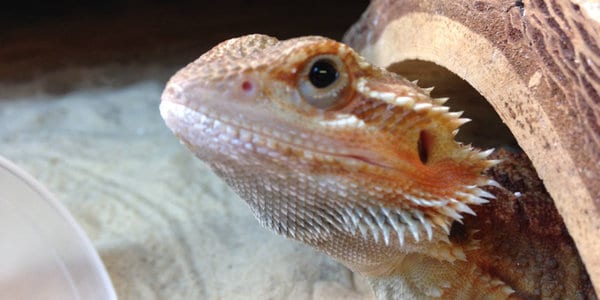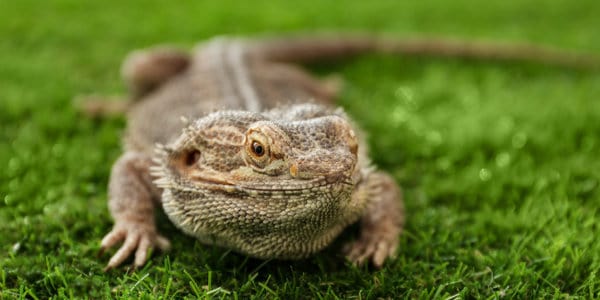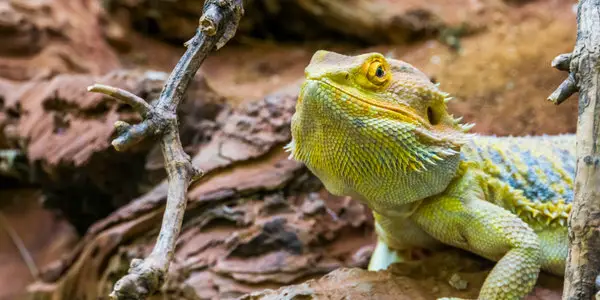When you add a bearded dragon to your home, breeders and pet storekeepers will recommend a few routine care and maintenance practices. These include proper enclosure setup, diet, substrate, and regular baths.
However, probably no one will tell you about black spots on a bearded dragon’s body. Although bearded dragons have fewer health complications, there are still a few issues that may cause them discomfort.
The most unfortunate part is that most bearded dragons owners will know about these things once their beardie is already at home.
Once you buy a bearded dragon, you’ll have to deal with panic-inducing issues like black spots on your bearded dragon’s skin.
Typically, black dots don’t indicate something wrong with your lizard. Some spots may be caused by dirt, freckles, or color patterning.
However, certain spots might signal underlying health conditions, such as fungus, stress, skin rot, parasite infestation, or burn mark.
As a bearded dragon owner, it might be challenging to determine whether the black spots on your bearded dragon’s body are harmful or harmless.
But since bearded dragons are quirky and expressive, you’ll probably notice when something is wrong.
What Causes Black Spots in Bearded Dragons
The good thing is that not all black spots result from infections or health complications. Some are just cosmetic and won’t affect your bearded dragon’s overall wellbeing.
Let’s look at some reasons why beardies may develop black spots.
Cosmetic and Harmless Bearded Dragon Black Spots
Color Patterns
Various bearded dragons come in different hues, such as olive green, tan, and yellow. Additionally, breeders are mixing multiple species to develop beardies with more colors.
Currently, there are over 20 morphs that bearded dragon lovers can buy.
When you get your bearded dragon from a reliable breeder, they’ll provide insights into the lizard’s color and what you should expect as it matures.
You’ll be able to understand whether the black spots on your beardie are part and parcel of its color pattern.
It is easy to identify color spots since they don’t disperse or increase in number. If the black spots are not part of your lizard’s color, you’ll notice them spreading throughout the bearded dragon’s body.
However, the baseline is that the black spots on your pet’s skin might be part of its natural color pattern.
Freckles
Humans and other animals such as cats, dogs, and even elephants usually have tiny spots known as freckles. Like all these animals, bearded dragons may also develop freckles, although not often.
Freckles may naturally appear on the bearded dragon’s skin, but in most instances, they manifest after an improper shedding process.
When the bearded dragon’s skin peels off earlier than expected during shedding, it fails to regrow correctly, leaving small dark spots known as freckles.
Freckles are harmless and shouldn’t raise concern. However, keep an eye on the spots to ensure that they don’t increase in size or spread rapidly to other areas. If they spread or expand in size, those are not freckles.
Dirt Patches
Bearded dragons may not be the dirtiest reptiles, but they may pick up specks of dirt and feces from time to time in their enclosures.
So, at times the black spots on your bearded dragons are dirt patches that the creature gathered as it traversed its tank.
Often, bearded dragons soil themselves when left to explore the yard or when a substrate mixture is lost within the enclosure. Dirt spots are often observed around the mouth and on the chest.
The only way to be sure that you’re dealing with dirt spots and not anything else is to give your beardie a full bath at least twice or thrice per week.
Bathing your bearded dragon will help get rid of any dirt specs and keep its skin hydrated.
Please bathe your pet with warm water. Being ectothermic, dragons rely on the external environment to maintain their body temperature. Using cold water can inhibit temperature regulation.
Bearded Dragon Femoral Pores
Bearded dragons usually have black dots on the underside of their hind legs, known as femoral pores. If it’s your first time dealing with bearded dragons, you might want to understand whether it’s normal for beardies to have these dots.
Bearded dragons are territorial animals that keep marking their territories now and then.
The femoral pores (black dots) that line up beneath the hind legs produce a waxy substance that beardies use to designate their territories and signal possible mates.
Underneath each pore sits a gland that secretes the waxy substance used to mark territories. Beardies rub their legs on various items, leaving the secretion to mark their territory or invite mating partners.
If a bearded dragon is not given a warm bath regularly, the pores can get clogged.
So, the next time you see this dark lines of black spots underneath the bearded dragon’s hind legs, you’ll understand that they have their role and don’t point to an underlying condition.

Bearded Dragons Black Spots that Indicate Health Complications
Scrapes and Cuts
Bearded dragons are active and vibrant animals that will keep climbing on rocks and moving around their enclosures.
Due to their curiosity, they like to try out various things that often leave them with scrapes and cuts.
Scrapes and cuts are typical to beardies and shouldn’t worry anyone as long as they are not too deep and are cleaned and disinfected.
Once these cuts and scratches dry out, they may leave dark spots that aren’t dangerous.
Unfortunately, the risk of infection increases when bearded dragons get their skin scratched or cut.
Pet owners should monitor the cuts to ensure that they’re not infected. Once infected, the spots turn too dark and spread all over the beardie’s body.
When the skin turns black, tissues and cells are dying, a condition known as necrosis. If you detect a dark spot near a cut or scrape, you should immediately seek veterinary treatment.
Bearded dragon owners must have the right tools to clean and disinfect any scrapes and scratches and should keep the enclosures clean to reduce the risk of the cuts being infected.
Heat Burn Marks
Black spots on a bearded dragon’s skin might also be due to excess heat in the enclosure. When the heat lamps in the basking area are placed too low, they might burn the lizard’s skin.
Although heat burns manifest as discolored spots, they may turn black when infected, just like scrapes.
If you notice that your bearded dragons are trying to avoid the basking area and have discolored spots on the skin, this is an indication that the heat is too much.
You’ll have to transfer the lamps to a safer distance if you want this problem to go away. Continuous exposure to too much heat can also lead to dehydration.
Many pet owners claim that raw honey helps treat burns and ease the pain. However, we recommend that you consult a reptile vet if you want to reduce the risk of infection on heat burns.
Fungal Infection
A fungus is another reason that your bearded dragon has some dark spots. The worst thing about a fungus is that it spreads faster and has a higher chance of recurring.
Usually, a fungus starts as a tiny dot and quickly increases in size. Any fungal infection should be reported to a vet immediately.
A fungus is generally treated with antifungal medications. However, if medicine fails, the infected part will have to be surgically removed or amputated to prevent further spread.
A fungus is very dangerous as it can lead to toes and tail amputation. If you detect earlier enough, a fungus can be cured without visiting the vet.
Treat a fungus; you’ll have to give your bearded dragon a betadine bath daily. The only thing you’ll add to the usual warm water to bathe your beardie is betadine.
If you’re a bearded dragon lover, you need to ensure that your pet first aid kit has betadine. This component comes in handy for cleaning wounds, treating fungus, and curing burns.
Scale Rot
Scale rot is a common ailment that is caused by bacterial infection. Essentially, the condition leads to a portion of the beardie’s scale dying, leaving black spots.
Bearded dragons contract bacterial infections, such as scale rot, if they reside in filthy enclosures.
In mild cases, scale rot will only leave a few dark spots. However, severe scale lot can cause extensive tissue death and thus should be reported to the vet immediately.
Maintaining a clean and healthy habitat is essential if you don’t want your beardie to contract scale rot.
Additionally, pet owners should invest in a digital hygrometer to monitor and maintain humidity in the tank around 20% and 40%. Incorrect humidity levels can lead to black spots.
Parasites
Sometimes you may notice some moving black spots on your bearded dragon. These are parasites that have made your lizard their food source. Beardies are highly prone to both external and internal parasites.
Internal parasites affect the digestive system and cause the beardie to have blood spots in its poop or pass liquid poop.
On the other hand, external parasites attack the skin and may cause skin infections and leave bite spots.
Some parasites might transmit infections that leave the bearded dragon’s skin with dark marks. External parasites usually infest unsanitary and dirty enclosures.
Once you determine that your beardie has a parasitic infection, you’ll need to take it to a vet who will put it under quarantine.
Ensure you take advantage of this period to clean and sanitize the enclosure to eliminate all the parasites before the bearded dragon returns.
You’ll also need to clean or replace all the décor and accessories in the bearded dragon’s tank.
Stress Marks
Bearded dragons may seem calm and docile, but they also get stressed. Surprisingly, when these creatures are stressed, they develop black lines and spots in various parts such as the stomach, limbs, or beards.
Younger bearded dragons often display stress marks on their tummies, beard, and limbs.
If you discover oval dots or lines on your lizard’s stomach, there’s a high probability that it’s undergoing some form of stress or anxiety.
Since stress is one of the most significant concerns for bearded dragons in captivity, let’s get into details. We’ll answer a few questions to help you understand everything about stress marks.
Are Stress Marks Permanent?
Stress marks are not permanent spots that usually appear during the period when a beardie is going through a rough patch. How long they last depend on the matter stressing your bearded dragon.
If your lizard is worked up because of weekend noise from a nearby club, it will probably stay with stress marks until the noise goes away.
However, if your bearded dragon is stressed because of relocation, the black spots and lines will disappear once it becomes accustomed to the new environment.
Since bearded dragons tend to be emotionally unbalanced at their tender age, they often have stress marks until they get into adulthood.
However, keeping all factors constant, stress marks can last from a few hours to weeks, depending on the severity of the stressor.

What Situations Causes Bearded Dragons to Develop Stress Marks?
Any form of stress can lead to the bearded dragon having stress marks. Here are situations that may stress your lizard.
Relocation
Bearded dragons don’t like moving from one place to another. Once you relocate your bearded dragon to a new environment, it will be anxious for the first few days or weeks.
The change in scenery can have a significant impact that will lead to the creature having stress marks.
Stress marks are the physical expression of how a bearded dragon feels because of the sudden location change.
Don’t worry too much about relocation stress marks, as they will disappear as soon as the bearded dragon gets comfortable in its new environment.
However, ensure that you have the right tank size and the tank provides the right conditions.
An Enclosure that’s Too Hot or Too Cold
A bearded dragon’s tank should have a specific environmental temperature range in the basking and cooler zones.
A bearded dragon may develop stress marks if the temperature drop below the recommended level or the basking area becomes hotter than usual.
If you notice that the sleeping area is colder at night, you should ensure that the temperature ranges between 70°-75°F.
Conversely, you must maintain the basking spot area temperature around 85°F and 100°F.
Bearded dragon owners need to ensure a temperature gradient of 20°F between the basking area and the cool zone.
This ensures that the beardies can easily navigate to the cooler side to cool off when the basking area is too hot and vice versa.
Housing Two Bearded Dragons in the Same Enclosure
Bearded dragons are inherently territorial. When several dragons are placed in the same tank, they engage in a fierce fight until the dominant one subdues the weaker lizard.
In such a case, the submissive lizard will be leaving in fear, and most of the time, they won’t access food, water, and the basking area.
Putting multiple dragons in the same cage can cause anxiety and stress, especially to the weaker beardie that doesn’t have a fighting chance.
If you don’t want your bearded dragons to develop stress marks, please don’t put them in the same enclosure.
Small and Dirty Enclosure
The rule thumb when buying a bearded dragon’s enclosure is to ensure that it’s two times the size of the lizard on every end.
Like in the wild, your bearded dragons should have enough space to roam and exercise. Your tank should try to replicate the natural habitat as much as possible.
On the other hand, the enclosure should be regularly cleaned, dusted, and sanitized. A small, filthy tank may cause the bearded dragons to live in misery and develop stress marks.
However, don’t make the tank too large, as it might make insect hunting a daunting experience for bearded dragons.
Loud Noise
Another reason why bearded dragons may develop stress marks is noise pollution. If the beardie’s tank is positioned next to a busy highway or near a children’s playground, this can be an unpleasant experience for bearded dragons.
Other loud noises such as sudden dog barking, loud parties, and unexpected fireworks can also work up the beardie’s emotions and make them develop stress marks.
When choosing a location for your lizard, make sure you keep it away from areas that have prevalent noise pollution.
Read More: Why Do Bearded Dragons Hiss and Make Other Sounds? All Explained!
Poor Diet
Failing to give your bearded dragon adequate food and a proper diet can be stressful. Beardies need to devour a balanced diet like any living thing.
If a lizard isn’t getting the right nutrients, its immune system will be compromised, and it won’t be able to defend itself against infection.
The lack of quality and enough food can induce stress and anxiety, leading to the formation of stress marks either on the stomach, beard, or legs.
Read More: What Do Bearded Dragons Eat? Ultimate Guide

How Can I Get Rid of Stress Marks from a Bearded Dragon’s Body?
Unfortunately, there’s no medication or technique to get rid of stress marks. The only remedy to stress marks is to deal with the stressor.
If you manage to keep your bearded dragon stress-free, you may never have to deal with stress marks. Here are things you can do to reduce stress in beardies:
- Buy the right sized tank
- Maintain an optimal temperature in the cool and basking areas
- Keep the bearded dragon’s enclosure away from noise pollution
- Tidy up the enclosure regularly
- Let every dragon stay in its tank
- Give your bearded dragon a proper diet
- Kill boredom in the beardie’s tank by introducing toys, games, and hiding areas.
How to Calm Down an Anxious or Stressed Bearded Dragon
Although you can’t cure stress marks, there are a few things that you can do to distress your bearded dragon. These include:
A Warm Bath
One of the best ways to help your beardie come down is to give it a warm bath. Often stress and anxiety will make the bearded dragon dehydrated and make its skin dry.
Giving it a gentle 20-minute bath will restore its vigor and help cool it down.
Just ensure that the water you use to bathe your dragon is neither too hot nor too cold.
And more importantly, don’t submerge them in water such that they get water in their eyes and noses. Also, don’t approach the beardie from behind when picking it up.
Reduce Sensory Overload
There comes a time when human beings feel like they need a break from flickering lights, excess noise, and technology.
In the same case, bearded dragons also get a sensory overload and get overwhelmed by the elements surrounding them. These can, over time, exacerbate their stress levels and make them more anxious.
You can help your bearded dragon calm down by dimming the light a little bit, taking it out of the tank, and covering the tank with a towel to block all external elements.
Gently Stroke and Massage the Bearded Dragon’s Head
One sign of a stressed bearded dragon is that they don’t like being handled. However, if you have created a good rapport with your lizard, this is the best time to show your beardie you care.
Look for signs that your beardie won’t mind being stroked and if it accepts, massage it with one finger starting from the nose going up to the crown of its head.
However, if your bearded dragon reacts angrily when you try to touch it, minimize handling to only when it’s necessary.

Final Verdict
Bearded dragons might be one of the best lizards to keep as a pet, but owning a beardie comes with the responsibility of knowing when they are okay and when they’re not.
One of the toughest challenges as a pet owner is determining whether the bearded dragon turning black are cosmetic or are an expression of something that is ailing them.
Especially for new dragon owners who don’t have previous experience.
Essentially, bearded dragons may have black spots that are naturally occurring, and sometimes they might be suffering from serious conditions or going through tough times.
If it’s the first time hearing about this, our in-depth guide will help you distinguish between harmful and harmless black spots and what causes them.
Furthermore, we’ve gone a step further to help you understand everything about stress marks, which are the most probable types of spots you’ll likely see in your new bearded dragon.
READ NEXT:
